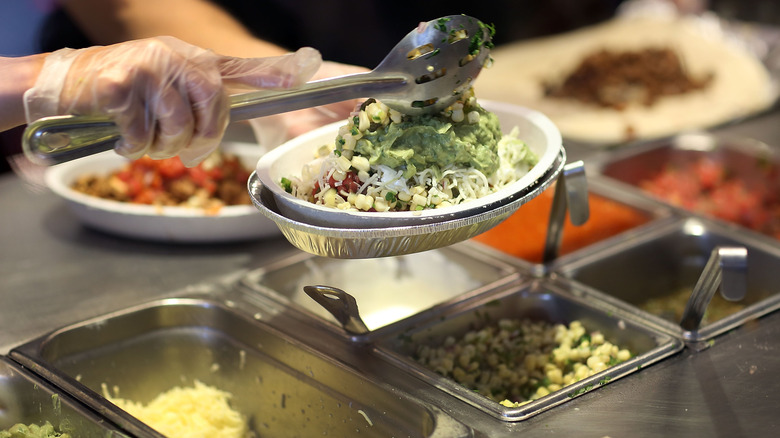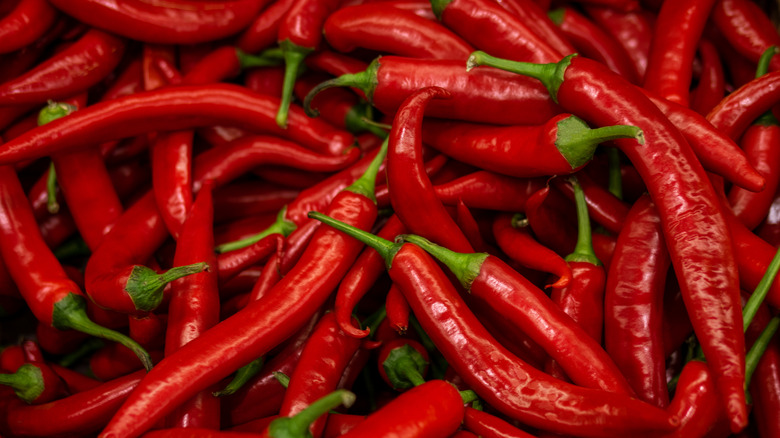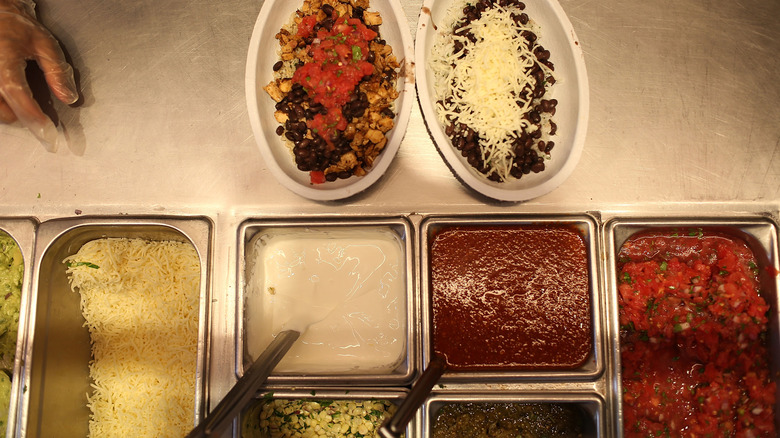Has The Heat Been Turned Up On Chipotle's Red Salsa?
Heat-seekers love Chipotle's tomatillo red chili salsa. One bite of salsa on your burrito or bowl, and you'll get an immediate kick of heat, followed by an even spicier aftertaste that might leave you craving milk. Chipotle's salsa certainly packs a punch, but is it getting even spicier?
The internet is full of rumors that Chipotle has turned up the heat on its red salsa. (If you prefer a milder salsa, no worries — no one has anything unusual to say about the less spicy options.) Is there any credence to the swirling speculation that Chipotle has made its hottest salsa hotter in recent months? And is Chipotle secretly trying to scorch our taste buds for some mysterious reason? The "heat factor" of Chipotle's red chili pepper salsa comes down to the ongoing supply chain issues, the regions from which the chain sources their chili peppers, and the conditions in which the peppers grow, though the effects on our taste buds remain to be seen.
How is a chili pepper's heat level measured?
To understand the potential differences in Chipotle's salsa, it's important to know how to measure salsa's heat levels. Salsa typically contains at least one type of chili pepper, so an easy way to gauge how hot peppers are is to measure the spice level of the chilis in any given salsa recipe. Thankfully, chili peppers have their own heat-measuring scale, so figuring out a salsa's spiciness is completely possible for food scientists.
The unit of measurement for a pepper's heat level is the Scoville unit. Bell peppers and other sweet peppers typically fall below 100 on the Scoville scale, while the notoriously spicy Carolina Reaper pepper comes in at 2.2 million Scoville units. Pure chile de arbol peppers are anywhere between 15,000 and 30,000 Scoville units, but thankfully, Chipotle isn't making us eat chile de arbol all by itself. Since Chipotle's salsa has other ingredients mixed in with the peppers, it won't be as hot. But why does Chipotle's salsa seem to be getting hotter by the day?
Is Chipotle's salsa spicier than ever before?
Chipotle's chili pepper salsa prominently features chile de arbol, a fairly spicy pepper. But if they haven't changed the type of pepper they use, why does the salsa seem like it's gone from fairly hot to burning?
Chipotle has had to change the regions from which they source their chiles in response to ongoing issues with the supply chain. The chiles come from all over the world now but particularly from parts of Mexico and India. Although chilis are planted and harvested fairly uniformly, the climate in any given location can influence how spicy the peppers become. If the climate is dry enough that the pepper plants don't receive much water, they'll be spicier than normal, and with climate variations throughout the world, it's entirely possible that the chilis in these regions haven't gotten as much water as they have in the past.
A Wall Street Journal study of Chipotle's red salsa found that it typically falls between 2730 and 3420 Scoville units, around the same as Tabasco sauce or a milder jalapeño. This heat variation is normal, though. According to Eat This, Not That, Chipotle has commented on the recent salsa debacle, stating that they "use dried red chili peppers sourced seasonally from varying regions that can have a range of different heat levels."


